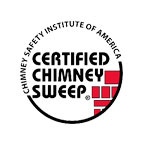In 2000, the National Fire Protection Agency, also known as the NFPA, revolutionized the way the chimney industry performed chimney inspections. In the NFPA 211 Standard, they developed specific guidelines for inspecting chimneys by establishing a three-tier inspection system–Level 1, Level 2 and Level 3. These levels allow a uniformity amongst chimney professionals throughout the country.
These levels of inspections have clear-cut and explicit guidelines. The NFPA 211 is an industry standard that indicates which level of chimney inspection to use depending on various scenarios.
We here at Swede Chimney Sweep are one of the few CSIA Certified Chimney Sweeps in San Diego County that performs the three levels of chimney inspections!
Here is a brief explanation of the three levels:
Level 1 Chimney Inspection
This is a common inspection done annually as a part of your normal chimney maintenance.
If you won’t be changing the type of fuel you use and if there have been no performance problems, a Level 1 inspection is sufficient. Readily accessible portions of the chimney exterior, interior, and portions of the appliances are inspected. Inspecting the chimney from the rooftop is not part of this inspection.
Level 2 Chimney Inspection
This level of inspection is recommended in these situations:
- When there has been a change of fuel type, such as going from wood burning to artificial gas logs
- Before installing an appliance such as a stove insert
- Before relining a chimney or replacing
- As part of the inspection process during a real estate purchase
- After malfunctioning of the system or a chimney fire event
- After an external event such as an earthquake, lightning strike, or major weather event.
Level 2 Chimney Inspections are much more thorough and in-depth than Level 1 Chimney Inspections.
Many chimney professionals will use a video camera to inspect the flue lining inside the chimney. These video scans can see aspects of the flue pipe that a Level 1 inspection cannot see.
In addition to using a video camera, the chimney professional may also inspect accessible portions of the system, such as attics, crawl spaces, and basements.
Level 3 Chimney Inspection
This type of chimney inspection is rare and recommended only when a Level 1 or Level 2 Chimney Inspection is not sufficient to determine the condition of the system.
A Level 3 inspection may entail dismantling the chimney system or cutting into walls in order to gain access to areas that otherwise could not be inspected.
The NFPA 211 is considered a Standard and is not a building code.
The National Fire Protection and the Chimney Safety Institute of America recommend annual maintenance of the chimney system and sweeping if needed.
Here is further information about the Levels of Inspection from the Chimney Safety Institute of America:
Notes for the Home Buyer
Always have a chimney inspection performed by a CSIA Certified Chimney Sweep.
You cannot make the assumption that your home inspector has any  training with chimneys. In addition, home inspectors can only inspect what they can see. If the chimney is dirty, then it would be impossible for anyone to inspect the condition of the flue lining through a layer of creosote.
training with chimneys. In addition, home inspectors can only inspect what they can see. If the chimney is dirty, then it would be impossible for anyone to inspect the condition of the flue lining through a layer of creosote.
We’ve had countless situations where a new homeowner had just purchased the home and wanted the chimney swept. The home inspector had said that the chimney was in fine working order. Upon inspection, we found extensive and expensive damage to the flue lining. If the home buyer had had a Level 2 chimney inspection, these dangerous issues would have been found before they bought the home.
There have also been countless times that a home seller, who has been obligated to have the chimney swept as part of the real estate transaction, will tell us “just sweep it, don’t write down any problems.” We not only consider this unethical but we could be liable if we didn’t report a hazard that we find. In cases like that, we politely pack up and leave. Certified Chimney Sweeps sign a very strict ethics clause which reinforces our high level of integrity in our work.

